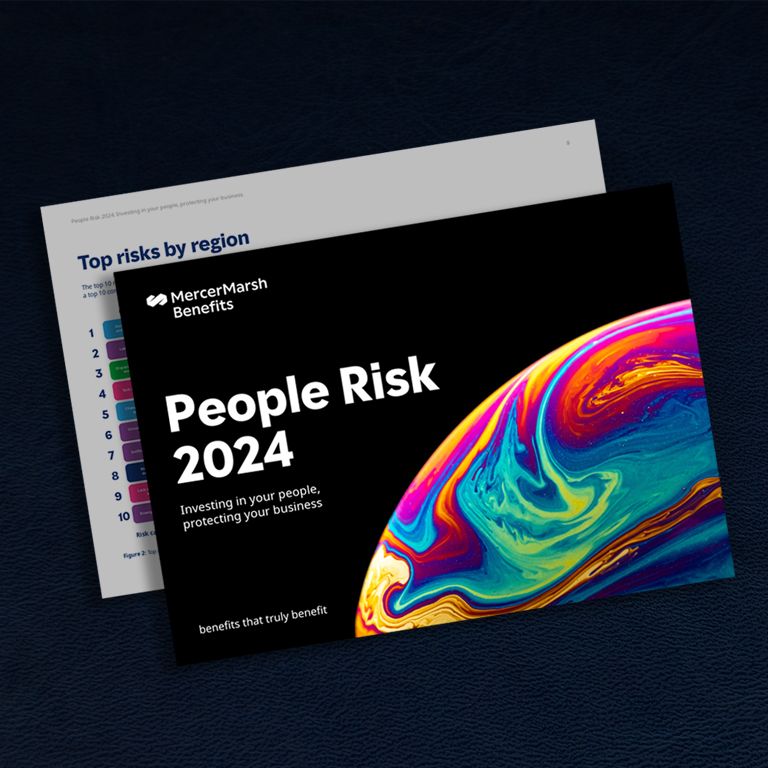
Joan Collar
Asia and Pacific Leader, Mercer Marsh Benefits
We are seeing the world’s healthcare systems in crisis, with the people who rely on them unsure of where to turn. Services have been overwhelmed by the impacts of climate change, financial crises, war, geopolitical disruption, and — most significantly — the COVID-19 pandemic. At the same time, labor shortages have led the World Health Organization to predict there will be a global shortage of 18 million health workers[1] by 2030.
There can be no doubt we have reached a critical point. Such is the scale of these issues, the WEF warns that we could even be facing the “first rollback in human development in decades”[2].Even in countries with established, mature national healthcare systems, patients are feeling pressure. In the UK, a record high 7.2 million people[3] are now waiting for NHS treatment, with over 400,000 people waiting over a year to be seen.
In markets with an aging population, the funding of the national healthcare plans has become very strained. For example, in Japan, where insurance premiums cover less than half the insurance gap, the government is having to fund the rest against the backdrop of an ‘ultra-aging’ society[4]. All of this means that as systems crack, from infrastructure to a lack of systemic funding, governments will need to innovate to provide the support needed.
As employers, we need to recognize this new reality and can no longer distance ourselves from employees’ health. We can no longer question the need to invest in our employees’ well-being. We have the chance to make a difference, to show employees and their families that we understand their concerns and to provide them with the help and support needed to get through challenging times.
For too long, in many markets, employee health benefits have been the preserve of a small group of directors, senior managers and professionals at the top of the organization, while the much larger group of low-income and part-time workers at the bottom have missed out. This has created a “benefits income paradox,” where the people who would gain the most from healthcare benefits are the ones least likely to have access.
For example, our Health on Demand 2023 report found that 30% of above-median earners have access to mental health counselling services, compared to just 22% of those with a below-median income, while part-time workers (38%) are more than twice as likely to have no benefits than fulltime employees (16%). The study also found that the more benefits an employee receives from their employer, the more likely the employee is to report “thriving” in their role and are less likely to leave their employer.
Companies can unlock opportunities to enhance the retention of employees and support employees’ well-being through offering benefits. Executives and benefits managers should acknowledge that a proportion of the workforce may not have access to benefits today, worry about affording healthcare, are coming to work unwell and potentially live below the poverty line. Employers should provide benefits to these vulnerable groups by “flipping the benefits pyramid.”
At the least, they should ensure these employees have access to a basic set of healthcare benefits through the workplace, including paid sick leave. They do not have to do all of this at once — it can be a multiyear journey, starting with the benefits that this group of employees would find most helpful. Above all, benefits managers need to embrace inclusivity and use it to inform their strategies and actions.
Source: MMB Health on Demand 2023.
Note: Benefits for this ranking refer to specific reproductive health, digital health, mental health, and general benefits queried in the survey. This does not refer to traditional benefits like life insurance or medical coverage.
This year’s Health on Demand report also highlights the need for HR and risk managers to develop a deeper understanding of the newest threats to employee health, so they can introduce policies and practices to address these.
Climate change and urbanization are growing threats to employees’ health. Extreme heat and air pollution, for example, can create dangerous working conditions — particularly for people with underlying health conditions. Air pollution is responsible for more than 6.5 million deaths annually — 70% of these in the Asia Pacific — with the most vulnerable at the greatest risk. The European Environment Agency cites air pollution as “the single largest environmental health risk in Europe, causing cardiovascular and respiratory diseases that lead to the loss of healthy years of life … and premature deaths.”
Addressing the cause of these environmental issues is, of course, a long-term societal goal. Employers can help to mitigate these factors in the short term by implementing sensible precautions. For example, organizations can invest in their work environments to protect workers from extreme heat and pollution, such as by installing cooling systems and air treatment plants.
They can also take steps to protect their most vulnerable workers. Employees suffering from asthma, for example, should be closely monitored, and possibly redeployed to areas of the business with lower exposure to airborne pollutants. Organizations in regions with high levels of air pollution should consider providing monitoring apps to all staff.
Employers should also carry out their own community-based vulnerability assessments. These can help identify the potential impacts of risks that might threaten particular communities, such as earthquakes, hurricanes, and other storms.
In the US, the Federal Emergency Management Agency (FEMA) provides guidance on how to carry out a threat and hazard identification and risk assessment. Such information can help employers anticipate different scenarios and put in place plans to support their employees. If there was a major flood in the organization’s local community, for example, how could the employer ensure that employees can access the medicines and other help they might need?
Vaccine hesitancy and misinformation is not new phenomenon, but its importance surged as a result of the COVID-19 pandemic. The spread of rumors and “fake news” about COVID-19 vaccines across social media, has been found to affect people’s intentions to get vaccinated — leading to increased infection rates, as well as greater divisions across society.
Employers are in a prime position to tackle these issues. They are a trusted source of information and can provide health education and promote vaccination programs to employees.
Firstly, they must listen to their workforce to gain an idea of what barriers might be preventing people from getting vaccinated. Secondly, they should design a communications program that addresses these barriers and educates all employees about the benefits of vaccination. Finally, they can provide paid time off work for employees to attend vaccination centers, or even set up their own on-site vaccination programs.
MMB’s Health on Demand report in 2023 found that violent crime – including workplace violence – is a major concern for employees across the world. Employees in growth markets such as Latin America are particularly impacted, with people worried about their personal safety, as well as that of their families.
Employers are in a unique position to help support employees who have such concerns. Many are taking action, including:
Employers can help society make the transition to digital health services. While the appetite for such services is growing, most employees still prefer to access health services in person. For example, 62% of people would favor a walk-in clinic or trusted doctor for a simple medical issue, compared to only 12% who would use telemedicine, according to Health on Demand 2023. On the plus side, 68% see potential in future tools such as virtual reality.
Employees also trust their workplace to deliver personal health solutions; employers can help to bridge the digital health gap by building confidence in digital solutions over time. They can start by investing in the key services that employees want and need, including digital health benefits that help people find and obtain healthcare or self-manage their own well-being. However, choosing the right provider will be crucial in encouraging trust and take-up — there is wide variation in the quality of applications available on the market.
Source: MMB Health on Demand 2023.
Note: Benefits for this ranking refer to specific reproductive health, digital health, mental health, and general benefits queried in the survey. This does not refer to traditional benefits like life insurance or medical coverage.
With health systems under enormous pressure and healthcare workers exhausted and in short supply, employers have a golden opportunity to give all their employees access to the services they need, right now. They have a chance to demonstrate genuine care and concern for their employees’ well-being. And, in doing so, they can start to shift their employees’ attitudes toward the digital future of healthcare.
This does not have to happen all of this at once – it can be a multiyear journey, starting with the benefits that employees would find most helpful. Understanding poorly supported groups in the workplace and addressing their needs requires absolute commitment from your top leadership. But employers need to take that first step. Now is the time to start supporting every member of your workforce and begin building trust for the long term.
Through your benefits strategies, you can make value-driven changes to address company priorities, while balancing cost containment and delivering important and convenient benefits that address all of your employees’ greatest needs. Not only will you be showing your workers that you care about supporting their wellbeing, but you will be creating an environment that will better enable them to thrive.
[1] https://www.who.int/news/item/28-05-2019-addressing-the-18-million-health-worker-shortfall-35-concrete-actions-and-6-key-messages
[2] https://www.weforum.org/reports/global-risks-report-2023/digest/
[3] https://www.bma.org.uk/advice-and-support/nhs-delivery-and-workforce/pressures/nhs-backlog-data-analysis
[4] https://impact.economist.com/perspectives/sites/default/files/health_system_sustainability_in_japan_en_whitepaper.pdf.

Asia and Pacific Leader, Mercer Marsh Benefits

President, Health & Benefits, Mercer and Marsh
France

Report
22/04/2024